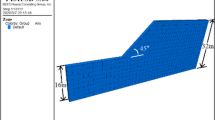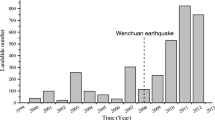Abstract
Separated analyses are available for evaluating slope stability after seismic shaking and rainfall. However, the combined effect of seismic shaking and rainfall water seepage on slope stability has not yet been well studied. In this study, the stability of the designed 30° and 45° slopes was analyzed under static, rainfall seepage, and seismic conditions. The soil shear strength reduction method was adopted to determine the factor of safety (FS) of the slope through the plane strain model of the finite difference method. The factor of safety and failure mode of the slope were studied for the interaction mechanism of seismic shaking and rainwater seepage. The numerical analysis results indicate that the soil friction angle has stronger effects on the slope stability than the soil cohesion does under the same slope conditions. The failure surface observed for biaxial seismic shaking was different from that observed for uniaxial seismic shaking. The combination effects of multi-axial seismic shaking must be considered when analyzing the failure mode of the slope. Seismic shaking after rainwater seepage results in a low FS and changes the failure mode of the slope. The FS continuously decreased with the biaxial and post-rainwater seepage seismic shaking of the slope. Seismic analysis after rainwater seepage is important for safety evaluation and disaster prevention in landslide-prone areas.


(Source: Central Weather Bureau in Taiwan, 1999)













Similar content being viewed by others
References
Bontemps N, Lacroix P, Larose E, Jara J, Taipe E (2020) Rain and small earthquakes maintain a slow moving landslide in a persistent critical state. Nat Commun 11:780. https://doi.org/10.1038/s41467-020-14445-3
Catane S, Cabria H, Zarco M, Saturay R Jr, Mirasol-Robert A (2008) The 17 February 2006 Guinsaugon rock slide-debris avalanche, Southern Leyte, Philippines: deposit characteristics and failure mechanism. Bull Eng Geol Environ 67:305–320. https://doi.org/10.1007/s10064-008-0120-y
Chen CY, Wu WC (2019) Combined effect of rainfall seepage and seismic shaking on slope stability by using a three-dimensional stability analysis. Int J Eng Technol 11:39–43. https://doi.org/10.7763/IJET.2019.V11.1120
Cheng LY, Li J, Chen S, Chu XJ (2013) An application of the maximum shear strain increment in searching sliding surfaces. Appl Mech Mater 423–426:1618–1622. https://doi.org/10.4028/www.scientific.net/AMM.423-426.1618
Chigira M (2011) Geologic and geomorphological characteristics of deep-seated catastrophic landslides induced by rain and earthquakes. J Chin Soil Water Conserv 42:265–275
Cruden DM, Varnes DJ (1996) Landslide types and processes. In: Turner AK, Shuster RL (eds) Landslides: investigation and mitigation, Transportation Research Board. Special Report No., vol 247, pp 36–75
Dawson EM, Roth WH, Drescher A (1999) Slope stability analysis by strength reduction. Geotechnique 49:835–884. https://doi.org/10.1680/geot.1999.49.6.835
Evans SG, Guthrie RH, Roberts NJ, Bishop NF (2007) The disastrous 17 February 2006 rockslide-debris avalanche on Leyte Island, Philippines: a catastrophic landslide in tropical mountain terrain. Nat Hazards Earth Syst Sci 7:89–101. https://doi.org/10.5194/nhess-7-89-2007
Faris F, Wang F (2014) Stochastic analysis of rainfall effect on earthquake induced shallow landslide of Tandikat, West Sumatra, Indonesia. Geoenvironmental Disasters 1:12. https://doi.org/10.1186/s40677-014-0012-3
Gong WJ, Li MY, Wu Z (2012) Stability analysis of landslide under coupling action of earthquake and rainfall—taking the No. III landslide of Xihe County, Gansu Province as an example. Northwest Seismol J 34:161–166. https://doi.org/10.1007/978-981-13-2227-3_61
Griffiths DV, Lane PA (1999) Slope stability analysis by finite elements. Geotechnique 49:387–403. https://doi.org/10.1680/geot.51.7.653.51390
Ho DYF, Fredlund DG (1982) Increase in strength due to suction for two Hong Kong soils. In: Proceedings, ASCE geotechnical conference on engineering and construction in tropical and residual soils, Honolulu, Hawaii, pp 263–295
Itasca Consulting Group, Inc. (2005) Fast language analysis of continua in 3 dimensions, version 3.0, user’s manual
Luzon PK, Montalbo K, Galang J, Sabado JM, Escape CM, Felix R, Lagmay AMF (2016) Hazard mapping related to structurally controlled landslides in Southern Leyte, Philippines. Nat Hazards Earth Syst Sci 16:875–883. https://doi.org/10.5194/nhess-16-875-2016
Matsui T, San KC (1992) Finite element slope stability analysis by shear strength reduction technique. Soils Found 32:59–70. https://doi.org/10.3208/sandf1972.32.59
Nguyen VBQ, Kim YT (2020) Rainfall-earthquake-induced landslide hazard prediction by Monte Carlo simulation: a case study of MT. Umyeon in Korea. KSCE J Civ Eng 24:73–86. https://doi.org/10.1007/s12205-020-0963-8
Pu X, Wan L, Wang P (2021) Initiation mechanism of mudflow like loess landslide induced by the combined effect of earthquakes and rainfall. Nat Hazards 105:3079–3097. https://doi.org/10.1007/s11069-020-04442-6
Qi X, Tang C, Chen Z, Shao C (2012) Coupling analysis of control factors between earthquake induced landslides and subsequent rainfall-induced landslides in epicenter area of Wenchuan earthquake. J Eng Geol 20:522–531
Ruan Y, Shi B, Yang J, Peng S (2018) The slope stability analysis under the coupling effect of earthquake and rainfall. In: Zhan L, Chen Y, Bouazza A (eds) Proceedings of the 8th international congress on environmental geotechnics, vol 3, pp 497–506
Saito H, Uchiyama S, Hayakawa YS, Obanawa H (2018) Landslides triggered by an earthquake and heavy rainfalls at Aso volcano, Japan, detected by UAS and SfM-MVS photogrammetry. Prog Earth Planet Sci 5:15. https://doi.org/10.1186/s40645-018-0169-6
Sassa K (2005) Landslide disasters triggered by the 2004 Mid-Niigata Prefecture earthquake in Japan. Landslides 2:135–142. https://doi.org/10.1007/s10346-005-0054-4
Sassa K, Nagai O, Solidum R, Yamazaki Y, Ohta H (2010) An integrated model simulating the initiation and motion of earthquake and rain induced rapid landslides and its application to the 2006 Leyte landslide. Landslides 7:219–236. https://doi.org/10.1007/s10346-010-0230-z
Sun J, Wang L, Long P, Chen G (2011) An assessment method for regional susceptibility of landslides under coupling condition of earthquake and rainfall. Chin J Rock Mech Eng 30:752–760
Tiwari B, Ajmera B, Tran D (2017) Influence of post-earthquake rainfall on the stability of clay slopes (IPL-192). Workshop on World Landslide Forum WLF 2017: Sassa K et al (eds), Advancing Culture of Living with Landslides, 4th World Landslide Forum. Ljubljana, Slovenia, May 29–June 2, pp 429–436
Toyota H, Takada S, Susami A (2017) Mechanical properties of saturated and unsaturated cohesive soils with stress-induced anisotropy. Géotechnique 68:1–44. https://doi.org/10.1680/jgeot.17.p.018
Yang ZH, Lan HX, Liu HJ, Li LP, Wu YM, Meng YS, Xu L (2015) Post-earthquake rainfall-triggered slope stability analysis in the Lushan area. J Mt Sci 12:232–242. https://doi.org/10.1007/s11629-013-2839-6
Yen QJ (2000) Numerical analysis. Beihang University Press, Beijing (in Chinese)
Yoshida Y, Kuwano J, Kuwano R (1991) Effects of saturation on shear strength of soils. Soils Found 31:181–186. https://doi.org/10.3208/sandf1972.31.181
Zhang K, Cao P, Bao R (2013) Progressive failure analysis of slope with strain-softening behaviour based on strength reduction method. J Zhejiang Univ Sci A Appl Phys Eng 14(2):101–109
Zienkiewicz OC (1973) Finite elements—the background story. In: Whiteman J (ed) The mathematics of finite elements and application. Academic Press, New York, pp 1–37
Acknowledgements
The comments of anonymous peer reviewers significantly improved this manuscript.
Author information
Authors and Affiliations
Corresponding author
Ethics declarations
Conflict of interest
The authors declare that there is no conflict of interest regarding the publication of this paper.
Additional information
Publisher's Note
Springer Nature remains neutral with regard to jurisdictional claims in published maps and institutional affiliations.
Rights and permissions
About this article
Cite this article
Chen, CY., Chen, HW. & Wu, WC. Numerical modeling of interactions of rainfall and earthquakes on slope stability analysis. Environ Earth Sci 80, 524 (2021). https://doi.org/10.1007/s12665-021-09855-5
Received:
Accepted:
Published:
DOI: https://doi.org/10.1007/s12665-021-09855-5




